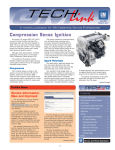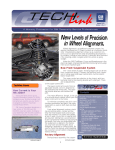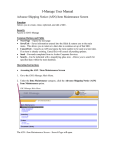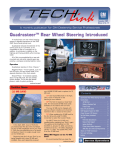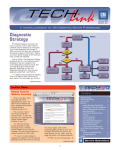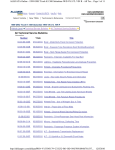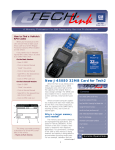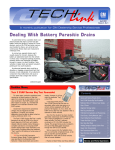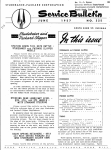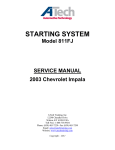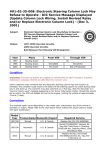Download Here`s
Transcript
July 2001 Volume 3, No. 7 Techline News How to Find Control Module References in SI2000 It’s often helpful to know exactly what control modules are installed on the vehicle you’re servicing. Here’s a quick way to find a list. - Go to SI2000 - “Build” the vehicle - Select View Service Manual - In the keyword search box, type “control module references” Testing the This will bring up a table of every module available on the specified vehicle. The modules are listed in the left column. Other column headings are: - Repair Instructions - Diagnostic System Check - Schematics Multec 2 Fuel Injector Within each table box, there are hot links to the highlighted information. Although this is a helpful directory, you should not ignore good diagnostic practice. Follow the diagnostic procedures provided, and replace compo nents only when instructed to do so. – Thanks to Mark Stesney Obtaining Broadcast Codes There are various ways to identify the standard and optional equipment on a vehicle. In this example, we’ll assume you have a 2002 GMC Envoy with a 4speed automatic transmission in your service bay. How would you describe the transmission? The model of the transmission is the 4L60E, which is also known as RPO M30. But if you go to the parts department to obtain parts for that transmission, they will want to know the broadcast code. This is a number which is related to the specific calibrations or running changes in the transmission. During the production year, there may have been a change in a spring calibration or a valve, for instance, which would result in a different broadcast code. Components that have a broadcast continued on page 3 In the January 2001 issue of TechLink, we covered the subject of fuel injector testing. Here’s some additional information, which pertains to the Multec 2 injector. Comparison of Multec 1 and Multec 2 Injectors The original Multec 1 injector was used from 1985 through 1999. In this injector design, the electrical coil was exposed to the fuel that passed through the injector. The fuel acted as a coolant for the coil. Some high alcohol content fuels and cleaners could erode the insulation on the coils, leading to a failure. To address the condition, the Multec 2 injector was introduced in 1999. Its design is much different from the Multec 1 in that the internal coil is separated from the fuel that is passing through the injector. This eliminates coil shorting due to insulation erosion. The diameter of the Multec 2 is about 1/2 that of the Multec 1, and it is also lighter. Although the Multec 2 has a quicker opening response, the stroke of the core is twice the length of the continued on page 3 1 Contents Testing the Multec 2 Fuel Injector . . . . . . . . . . . .1 How to Find Control Module References in SI2000 1 Obtaining Broadcast Codes . . . . . . . . . . . . . . . .1 Transmission Shift Conditions . . . . . . . . . . . . . . .2 Tech Tips Exhaust Rattle at Idle . . . . . . . . . . . . . . . . .4 Sulfur Smell from Exhaust . . . . . . . . . . . . . .5 Painted Axles on Camaro and Firebird . . . . . .5 Tracker PCM Can Be Reprogrammed . . . . . . .6 Head Restraint Migrates to Up Position . . . . .6 Uncommanded Shift to Auto 4WD . . . . . . . . .8 GM Towing Manual . . . . . . . . . . . . . . . . . . . . . .4 Duramax Diesel 6.6L Diagnostic Tips . . . . . . . . .5 TAC Tips . . . . . . . . . . . . . . . . . . . . . . . . . . . . . . Rough Idle . . . . . . . . . . . . . . . . . . . . . . . . .7 Aztek and Rendezvous Trailering Package . . . .7 Ambient Temperature too High . . . . . . . . . . .7 GM Goodwrench Remanufactured Engines . . .7 Bulletins . . . . . . . . . . . . . . . . . . . . . . . . . . . . .8 Service Operations Transmission Shift Conditions No Forward, Delayed Forward, Transmission may Lock Up in Reverse, Intermittent Affects 2000-2001 models equipped with the 4T65E Transmission RPO (M15, MN3, MN7) Vehicles with the subject condition will exhibit no forward or delayed forward intermittently. Some will not move intermittently when placed in reverse. Putting the vehicle in drive and then back into reverse may alleviate the condition temporarily. This phenomenon has been observed in only a very small number of vehicles in the field. The cause is a small nick on the forward band piston apply pin (21) that causes the apply pin to stick. Even though the nick may be quite small (no larger than the tip of a sharpened pencil), it may still be sufficient in size to cause the pin to stick. Replace the pin and any associated parts that are required to correct the condition. – Thanks to Chris Anderson GM TechLink is a monthly magazine for all GM retail technicians and service consultants providing timely information to help increase knowledge about GM products and improve the performance of the service department. This magazine is a companion to the GM Edge publication. Publisher & Editor: Mark Stesney GM Service Operations [email protected] Technical Editor: Jim Horner [email protected] 1-248-816-3641 Production Manager: Marie Meredith Desktop Publishing: Greg Szpaichler, MediaWurks [email protected] Slips, Erratic Shift, Harsh Shift Affects 2001 Cadillac DeVille, Eldorado and Seville, 2001 Aurora, equipped with 4T80 E (RPO MH1) It is possible for the subject condition to be caused by a faulty crank sensor. Premium V8s use two crank sensors allowing for significant redundancy should one sensor fail (two sensors allow faster synchronization - one sensor alone can provide approximately 90% functionality). If a crank sensor failure occurs, the powertrain operation is severely degraded until the diagnostic code(s) are set. This mode of operation could be interpreted as the transmission slipping or shifting erratically. When a crank sensor code sets while the car is being driven, it causes a momentary loss of engine output during transition to the other sensor. This may be interpreted as a very firm shift. So, if a technician is servicing a vehicle with the subject condition, it is important to address any DTCs associated with the crank sensor first (P0335, P0336, P0385, P0386, etc). – Thanks to Chris Anderson No 2nd or 4th Gear Some 4L60E transmissions in 2001 vehicles may experience a damaged 2/4 band with no obvious root cause. One possible cause of this condition may be a servo apply pin that does not move freely in its bore, causing the 2/4 band to drag when released. During transmission assembly, a gauge is used to determine proper servo apply pin length. If the gauge strikes the case near the apply pin bore, it is possible to dent the case. This dent may raise metal in the bore and cause the pin to drag. Inspect the case inside the servo bore for signs of a dent or damage near the apply pin bore. Also, inspect the apply pin for scratches or wear marks running lengthwise along the pin. If damage is noted, it may be possible to carefully remove the raised metal with a small file. If the raised metal cannot be removed, it will be necessary to replace the case or the transmission assembly, based on the most cost-effective repair. – Thanks to Mike Johnston FAX number: 1-248-649-5465 Write to: TechLink PO Box 500 Troy, MI 48007-0500 GM TechLink on the Web: http://service.gm.com General Motors service tips are intended for use by professional tech nicians, not a "do-it-yourselfer." They are written to inform those techni cians of conditions that may occur on some vehicles, or to provide information that could assist in the proper service of a vehicle. Properly trained technicians have the equipment, tools, safety instructions and know-how to do a job properly and safely. If a condition is described, do not assume that the bulletin applies to your vehicle or that your vehicle will have that condition. See a General Motors dealer servicing your brand of General Motors vehicle for information on whether your vehicle may benefit from the information. Inclusion in this publication is not necessarily an endorsement of the individual or the company. Copyright© 2001 General Motors Corporation All rights reserved. 2 Return to page 1 Multec 1, for improved resistance to contamination and reduced sensitivity to internal wear. The improved fuel flow path creates smaller spray particles and increased spray velocity, and also minimizes contamination traps. To guard against corrosion, stainless steel is widely used for internal components, including the director plate, which has precision holes to control fuel flow and spray targeting. You may identify the Multec 2 by the Delphi insignia on the body. The original Multec 1 has the RP lettering. Electrical Testing of the Multec 2 The most likely reason for performing an electrical test is due to engine misfiring on one or more cylinders. The electrical solenoid in the Multec 2 injector uses a high-impedance coil. This means it offers resistance to the electrical current flowing through it. A change in resistance will have a corresponding effect on the operation of the injector. Variations in fuel delivery can have an effect on driveability. Some symptoms include rough idle or intermittent misfire (the kind that does not set a cylinder-specific code). You may think that the J-39021 Fuel Injector Tester and digital voltmeter would be useful in diagnosing the Multec 2. Actually, the voltage drop test using the J-39021 and voltmeter was designed specifically for the Multec 1 and is not suitable for testing the Multec 2. Here’s why. In the Multec 2, the small wire size and rapid heat build-up within the coil will give erroneous readings of voltage drop. Coil shorting is not a problem in the Multec 2. However, in a very small number of cases, the winding may develop a break. When tested with the J-39021, this injector will actually pass the voltage drop test. It is theorized that the high current of the J-39021 bridges the gap in the winding, causing it to appear normal. For this reason, the best electrical test for the Multec 2 is the resistance test using an ohmmeter. To do this, disconnect the electrical connector from the Multec 2 and inspect the terminal pins. If they are satisfactory, connect your digital ohmmeter across the injector, using suitable test terminal adaptors. A satisfactor y reading is 11 to 13.5 ohms, at room temperature. The reading will increase as the temperature rises. If measurements are taken with engine coolant temperature above 100°F, or below 50°F, the best bet is to read all the injectors and compare readings, looking for sig nificant variations. Normal injectors should be within 1.5 ohms of each other. If the resistance is high (60-70 ohms), the coil cannot create enough magnetism, and the injector may not open. TIP: If all injector readings are satisfactory, and the engine now runs properly after checking resistances, the cause of a misfire may have been a poor connection at one or more injectors, which cleared up simply by disconnecting and reconnecting. Other Tests The J-39021 Fuel Injector Tester can be used to perform an injector balance test. See SI2000 for details. Be sure to set the selector switch to the 0.5-2.5 amp setting. Delphi also recommends using the injector noid light J-34730-405. When plugged into the connector in place of the injectors, the noid light permits you to verify that power is supplied to the injector and that the injector driver is functioning. – Thanks to Randy Pearl Using J-34730-405 noid light If the resistance is low (in the 4-5 ohm range), an internal short is indicated. Opening response time will be affected. Also, there’s a likelihood of excess heat being generated in the modules, ABS assembly, and others. code include engines, transmissions and transfer cases, axles, ECM/PCMs and other control shorted area. Of course, you can always check the broadcast code directly on the component, but that can entail putting the vehicle on a lift, using an inspection light and mirror -- you know the drill. Now, there’s a more convenient way. - Component Code On the Dealer World home page (http://www.gmdealerworld.com): - choose Service - choose GMVIS On the GM Vehicle Inquiry System page: - type in the last 8 digits of the VIN and submit - choose Vehicle Component in the page header. - Source Plant This will bring up a Vehicle Component list. For each com ponent, you will see: - Broadcast Code - Traceability Number TIP: Use the HELP key to obtain a definition of these terms. Your parts department will be able to use this information to help obtain the cor rect parts for your repair. – Thanks to Gloria Rogers 3 Return to page 1 Exhaust Rattle at Idle Towing News Some M/L vans trucks between 1996 and 2001 with L35 4.3L engine may exhibit an exhaust rattle noise. The noise is most likely very harsh, occurring near idle at 550 RPM. In some cases, engaging the AC compressor may increase the rattle. and pictures the equipment required to perform the towing procedures outlined in the book. These include auxiliary load spreaders fabricated of wood, safety chains, lift chains, T- and R-hooks, and towing dolly. The noise is most likely to occur in warm ambient temperatures with a hot exhaust system. The exhaust tailpipe will be visibly vibrating and the rear 1/3 of the muffler will be oilcanning while the noise is occurring. Applying pressure to the tailpipe will reduce or completely eliminate the noise. The condition may be caused by low clamp load on the exhaust seal at the takedown. This can be confirmed by applying pressure to the joint with a screwdriver while the noise is occurring. If the problem is in the joint, pressure will eliminate the noise. There are three standoffs on each exhaust flange bolted to the exhaust manifold. If any two of the standoffs on one flange is in contact with the manifold during a hot exhaust condition, the noise can occur. To correct this condition, lower the exhaust Y-pipe. Measure the height of the standoffs on the flanges. Remove 2mm from all 6 standoffs. Install new seals. Place the Y-pipe into position. Torque uniformly to 53 +/- 3 Nm. – Thanks to Marty Case answers The manual describes the location and purposes of recovery hooks incorporated on numerous new vehicles, and points out that they are not sub stitutes for securing the vehicle to a carrier. GM Towing Manual Here’s a towing pop quiz. Answers are at the end of the article. 1. Do you know why the ignition must be OFF when towing a 2001 Oldsmobile Alero? 2. Do you have to use a flat-bed carrier on a Corvette? 3. You will find recovery hooks on which of the following Cadillacs? DeVille, Eldorado, Catera, Seville 4. When attaching a Chevrolet Malibu to a carrier, where on the suspension do you attach the J-hooks? 5. Is it permissible to use a sling to pick up the front end of a Pontiac Firebird? Questions like these must be faced every day by tow truck operators who bring disabled vehicles to your dealership for service. And many of them will look to you as experts on the correct way to lift and tow the vehicles your dealership services. There is also a sec tion dealing with restraint systems, including air bags and the proper handling of deployed inflator modules. These manuals are distributed by: Helm, Inc . Publication Division 14310 Hamilton Avenue Highland Park, MI 48203 phone 800.551.4123 fax 313.865.5927 web address www.helminc.com Model Year 1995 1997 1998 1999 2000 2001 Manual Number T66 T67 GMPT98TOW GMPT99TOW GMPT00TOW GMPT01TOW - Thanks to Mike Ondr e Every year, GM updates and publishes the GM Passenger Car and Light Duty Truck Towing Manual with all these answers and more. Although your dealership received one copy, you may want to obtain addi tional ones for handy ref erence. An important feature of the manual each year is the What’s New section. Here, for 2001 you’ll find information on: - avoiding battery rundown while towing - dealing with remote keyless entry and content theft features The manual describes Front and rear hookups are shown for every vehicle. 4 Return to page 1 Duramax Diesel 6.6L Diagnostic Tips Here are some diagnostic tips you may find useful when diagnosing driveability concerns on the Duramax 6.6L diesel engine. Vaccum/Pressure Gauge Hookup Misfire If there is a misfire code, or a misfire can be detected during operation, connect the Tech 2. Look on the Engine Data 2 list to find the Balancing Rates for the cylinders. Balancing Rates This will show the amount of fuel being added to or taken away from each cylinder during normal idling. Normal fuel delivery to each cylinder is around 1 cubic millimeter (mm3) for the pilot injection and 7 mm 3 for the main injection. Balancing rates are available only during idle. These numbers tell you whether or not you have a possible compression problem or possibly an injector that is stuck open or closed. determine if air intrusion into the fuel system is the root cause of the complaint. With the vacuum/pressure gage hooked up, prime the fuel manager until 10 psi is reached. If pressure does not reach 10 psi after twenty or so pumps, air intrusion is the cause. Refer to the fuel system diagnostic in the manual. Once the misfire is detected, the balancing rate of the cylinder that has the miss will be slightly higher in mm3, or may be as high as 12 mm 3. The misfire codes (P0300s) will set only in the first 90 seconds of engine operation and will set only when the balancing rate of the “missing” cylinder goes above 7 mm3. In the case of a “cranks, no start” condition, use the Tech 2 to check for codes. If no codes are present, ensure that pressure is being made under Engine Data 1, looking at Actual Fuel Pressure. The normal values that should be seen on the balancing rate screen will range between -2.4 and +2.4. These numbers will move around constantly, based on the crankshaft speed. Suspect a possible problem when the balancing rate of a particular cylinder starts to go up in mm3. An example of a possible problem cylinder would be a balancing rate of 5 mm3 or so. Once the numbers start to creep up, the cylinder is progressively getting worse in performance. If pressure is being made, install the vacuum/pressure gage, follow the “cranks, no start” diagnostic and then prime the fuel manager until 10 psi is reached. If the 10 psi leaks down to zero faster than the specified time within the fuel system diagnostic, the problem could be internal to the high pressure pump. Observe the fuel system diagnostic and follow the guidelines provided in order to determine if the pump is the problem. Once the balancing rate has been determined to be higher than normal, follow the Smoke Table Diagnostic (White Smoke). Remove the glow plugs from the side of the engine that has the cylinder with the higher than normal balancing rate. Remove the ignition 1 relay to disable the injectors. Then, crank the engine and have someone observe the glow plug holes (from a distance, for safety reasons). The glow plug hole that has fuel spraying from it is the cylinder with the stuck open injector. - Thanks to Christopher Sterling breaking news Sulfur Smell from Exhaust Diagnosing “Spark Knock” Owners of some 2001 Chevrolet Trackers may comment about a sulfur smell from the exhaust, particularly when the vehicle has less than 800 miles. Balancing rates are also useful when diagnosing “spark knock” in the Duramax. The scenario would be a complaint of a “spark knock” during normal driving conditions other than the slight knock heard during shifting, which is normal. The sulfur smell is a normal operating characteristic, resulting from the highly efficient catalyst within the new coverter. As the catalyst ages through continued vehicle operation, the sulfur smell will diminish. Drive the vehicle and attempt to repeat the complaint. Once the “spark knock” begins to occur, take your foot off the accelerator, shift the vehicle into neutral, and take a snap shot using the Tech 2. This will allow the vehicle to enable Cylinder Balancing Rates during your drive. Observe these rates and note which cylinder(s) appear higher, compared with the other cylinders. The cylinder(s) with the higher than normal rates will indicate the injectors that are slightly sticking either open or closed during the driving condition in which the complaint occurs.The injector(s) may not show an abnormal balancing rate at idle. Once you verify the complaint and then perform the driving test, determine if the balancing rates are higher than normal. Although the exact mileage cannot be pinpointed, the smell should be significantly reduced in the first 2000 miles. Do not change the catalytic converter in response to customer comments regarding the sulfur smell, because it will not eliminate the smell. Installation of a new converter prolongs the duration of the smell because it starts the process over again. – Thanks to Donald B. Sherman Painted Axles on Camaro and Firebird The St. Therese Assembly Plant will install painted rear axles from about April 4 to the week of May 14, 2001 for engineering evaluation only. Vacuum/Pressure Gauge The vacuum/pressure gauge is also useful when diagnosing the Duramax 6.6L diesel. In the case of a complaint of “starts, runs, then dies,” or if the vehicle will not start after sitting for a period of 30 minutes or longer, hook up the vacuum/pressure gauge to the schraeder valve on the right front valve cover to Painted axles will not be standard production, so unpainted axles should not be painted in the field. – Thanks to Mike Ondr e 5 Return to page 1 Reminder: Ordering Replacement PCMs for 2001 Trackers Chevrolet Tracker PCM Can Be Reprogrammed For a number of years, the PCM in the Chevrolet Tracker could not be reprogrammed, and had to be replaced if a calibration change was needed. But effec tive December 1999, that is no longer true. The Tracker PCM for model years 1999 and newer can now be reprogrammed, as explained in bulletin 99-0604-060. Two Examples wher e Reprogramming is the Correct Solution Rough/Unstable Idle During Engine Warm Up -- Bulletin 00-06-04-013, issued in March 2000, addresses a rough idle condition on 1999-2000 Trackers with manual transmission. Customers may comment that the vehicle runs rough when idling with the clutch depressed after a cold start, before the coolant reaches normal operating temperature. The actu- Both production and service replace ment PCMs are available for order. Do not order a PCM with a part number that begins with 3002. These are production PCMs and are often damaged when recalibration is attempted. Correct PCMs are available for the US market using the following part numbers and applications: al idle speed may drop below the desired speed. Reprogramming the PCM is the proper correction for this condition. Tach Needle Fluctuation -- On 2001 Trackers with 2.5L V-6 engine and automatic transmission, some customers may comment that the tachometer seems to indicate a significant drop in engine RPM during a prolonged deceleration, in the form of a fluctuation or needle bounce. The tachometer is responding to signals received during decel fuel shutoff. Reprogramming the PCM to the latest calibration will correct the condition. 2.0 L, man trans, 4 dr 91176340 2.0 L, auto trans, 4 dr 91176341 2.0 L, man trans, 2 dr 91176342 2.0 L, auto trans, 2 dr 91176343 2.5 L, auto trans, 4 dr 91176346 Trackers built for sale in Canada or Mexico should use the following part numbers and applications: 1.6 L, man trans, 2 dr (Can) 91176338 1.6 L, man trans, 2 dr (Mex) 91176339 2.0 L, man trans, 2 and 4 dr (Mex) 91176344 2.0 L, auto trans, 2 and 4 dr (Mex) 91176345 – Thanks to Donald B. Sherman Head Restraint Migrates to the UP Position Avoiding Door Trim Cracks Owners of some 1997-2001 Buick Regal and Century, Pontiac Grand Prix, and 1998-2001 Oldsmobile Intrigue may comment that the head restraint does not stay in position on the seat, but migrates to the full-up position. On 2000-01 Chevrolet Impala, front door trim panels may be cracked or broken on the forward or rear edge of the panel. These cracks are typically in line with the door trim mounting bracket screws. To avoid this damage, before attempting to remove the trim panel, remove the two attaching screws located behind the armrest pull cup. Then disengage the trim panel retainers from the door inner panel, using J-38778. Remove the head restraint from the seat back by inserting a small diameter tool into the hole on each retainer and pressing. Removing head restraint Firmly grasp each rod and rotate it 90 degrees. Pull the rods out of the head restraint. Turn the head restraint over and look into the hole where the head restraint installs to the post. Locate the spring (wire) that fits into the detents on the posts. Insert a round-shanked tool such as an awl behind the spring and push the tool in, bending the wire toward the hole center. Overbending can either break the spring and/or not allow the post to be reinstalled. Test the operation of the head restraint after installation to assure it’s not too tight. – Thanks to Fred Tebbet and Wayne Zigler View of spring (wire) in hole Bending spring (wire) towar d center of hole Discard the trim panel retainers and replace with new ones when installing the door trim. – Thanks to Gary McAdam Tracker Hydraulic Valve Lifter Noise Some 1999 - 2001 Chevrolet Trackers with 2.0 and 2.5 liter engines have hydraulic valve lifter noise upon engine startup. The hydraulic valve lifter design may allow the oil to drain down. Air may get trapped in the valve lifters, not allowing for proper lifter adjustment. The valve lifter clatter can be heard until the air is eventually replaced by engine oil. GM Service Bulletin number 00-06-01-006A recommends purging the air by running the engine at 2000 RPM for about half an hour or until the air clears. – Thanks to Donald B. Sherman 6 Return to page 1 TAC Tips Rough Idle Some 2000 and early built 2001 model year Cadillac DeVille, Eldorado, Seville with 4.6L (LD8, L37) engines or 2001 Oldsmobile Aurora with 4.0L (L47) engine, may exhibit a condition of rough idle with no PCM DTC and no driveability complaints. A technical bulletin is expected to be released soon explaining that a camshaft and PCM calibration may be required. The camshafts must be replaced on all 2000 vehicles with 4.6L (LD8 or L37) engines and the early built 2001 vehicles with 4.0L (L47) or 4.6L (LD8 or L37) engines. 4.6L (LD8) VIN Code Y and 4.0L (L47) VIN Code C camshaft service part numbers: 12570333 RH INT 12570331 RH EXH 12570332 LH INT 12570334 LH EXH 4.6L (L37) VIN Code 9 camshaft service part numbers: 12570335 RH INT 12570337 RH EXH 12570336 LH INT 12570338 LH EXH For a 2001 vehicle, you must verify that it has the early cam profile by reading the 3 alpha characters of the broadcast code listed on the tag attached to the engine's rear cam cover. The broadcast codes for early 2001 engines are: Seville, DeVille applications: Engine VIN Code Y KMA Engine VIN Code 9 KKA Eldorado applications: Engine VIN Code Y KCA Engine VIN Code 9 KBA Aurora application: Engine VIN Code C KY A Once all four camshafts have been installed, the calibration must be updated. Contact Techline and tell them that the camshafts on the vehicle have been replaced. Techline will provide a VCI number to install the cor rect calibration. Techline must be contacted each time so that they have a record of when a camshaft change occurred on each vehicle. This will ensure that future calibrations for that vehicle will be correct. – GM Technical Assistance Ambient Temperature Reading Too High Owners of some 2001 Chevrolet Silverado or GMC Sierra trucks may comment that the ambient temperature reading in the rearview mirror is too high when the winter front is installed over the radiator grille to restrict air flow into the radiator and increase engine temperature. The sen sor is reading the engine compartment temperature instead of the ambient temperature due to its location. Reposition the ambient temperature sensor to an existing hole on the radiator support under the left turn signal assembly. This hole is exactly opposite the location used to install the air temperature sensor under the right turn signal assembly. Relocating the sensor will elimi nate the bracket in the original location. The wiring harness will now be 12 inches (304.8 mm) longer than needed. Neatly bundle the excess wire and install a suitable tie. Affected Models: 2001 Chevrolet Silverado C2, C3 2001 Chevrolet Silverado K2, K3 2001 GMC sierra C2, C3 2001 GMC sierra K2, K3 – GM Technical Assistance Aztek and Rendezvous Trailering Package The "High Performance" trailering package (RPO V92) available on FWD & AWD Aztek and Rendezvous includes the following items but does not include a hitch platform: - self leveling rear suspension (G67 auto level control) - compressor outlet for blowing up balls, bike tires, etc. - engine oil cooler - high output alternator (125 amp) - heavy duty engine cooling system - wiring harness The frame mounted hitch platfor m is now available from GMSPO. FWD Aztek only - 12497335 AWD Aztek & all Rendezvous 12497875 The maximum trailering capacity for these vehicles is 3,500 lbs which falls into the Class II categor y. Tongue load information is not available. Significant Quality Improvements in GM Goodwrench Remanufactured Engines GMSPO changed suppliers for the 4.3L (L35,LB4 ,LF6) GM Goodwrench engine assemblies during 1999 and has instituted several quality improvement items during this change-over. The cut-off date for the latest of all improvements was December 1999. Bulletin 00-06-01-019 has been released to help identify and resolve oil consumption concerns of the 4.3L remanufactured engines. To aid in the process of continuous improvement for this engine series, you are asked to provide the Serial number: 8 digit number and the engine build date sequence number information on the Repair Order in the event you need to replace a 4.3L GM Goodwrench engine. This information can be read from the engine ID tag. – GM Technical Assistance – GM Technical Assistance 7 Return to page 1 This review of service bulletins released through mid-June lists the bulletin number, superseded bulletin number (if applicable), subject and models. Synchronizer Assembly, 3rd Gear Blocker Ring and 3rd Speed Gear); 1999-2000 Chevrolet Camaro, Pontiac Firebird with Manual Transmission (RPO MM6) GENERAL INFORMATION: 01-07-30-002B; replaces 01-07-30002; Malfunction Indicator Lamp (MIL) On, Transmission Stuck in Third Gear, Instrument Cluster Inoperative (Replace Ignition Switch); various Utility models with 4L60E or 4L65E Automatic Transmission (RPOs M30, M32) 01-00-89-008; replaces 96000; Current CIPS Campaign Number to Previous Divisional Campaign Number; 2002 and Prior Passenger Cars and Trucks 01-00-89-009; Replacement of Keys, Key Numbers and/or Security Chips; 2002 and Prior Passenger Cars and Trucks HVAC: 99-01-39-004A; replaces 99-01-39004; Air Conditioning Odor (Install Kit); 1993-2002 Passenger Cars, Light & Medium Duty Trucks 01-01-38-006; Air Conditioning System Flushing Procedures and Guidelines; 1997-2002 Passenger Cars and Light Duty Trucks with Air Conditioning SUSPENSION: 00-03-10-003B; replaces 00-03-10003A; GM Tire and Warranty for Bumperto-Bumper Program; 1996-2001 Passenger Cars and Light Duty Trucks BRAKES: 01-05-23-006; Revised Fastener Requirements for Front and Rear Brake Caliper Bracket Replacement; various Car and Minivan Models ENGINE/PROPULSION SYSTEM: 01-06-01-015; Serpentine Belt Frayed (Replace Power Steering Pump Bracket and Serpentine Belt); 1999-2001 Chevrolet Tracker with 2.0L Engine (VIN C -- RPO L34) 01-07-30-018; Tech 2 Information on 4L60E Shift Adapts (Clearing Shift Adapts); 2002 Chevrolet TrailBlazer, GMC Envoy, Oldsmobile Bravada with 4L60E Automatic Transmission (RPO M30) and 4.2L Engine (VIN S -- RPO LL8) 01-07-30-020; 4L60E Valve Body, Spacer Plate and Gasket Kit (Ordering Reference Table); 1998-2001 Chevrolet Camaro, Corvette, Pontiac Firebird, 19992001 Chevrolet and GMC C/K Trucks with 4L60E Automatic Transmission (RPOs M30, M32) 01-07-30-021; replaces 83-71-10A; Park/Neutral Position Switch Connector Cannot Be Removed (Replace Switch and Connectors); various Passenger Car and Light Duty Truck Models with 4L60E (M30), 4L65E (M32), 4L80E (MT1) or Allison LCT (M74) Automatic Transmission BODY AND ACCESSORIES: 00-08-61-001B; replaces 00-08-61001A; Revised Assist Step Installation Procedure; 2000-01 Chevrolet and GMC Utility Models, 2002 Cadillac Escalade 00-08-49-006; Erratic Instrument Panel Indicators/Gauges (Needles/Pointers) When Vehicle Ignition is Switched On (Reprogram Instrument Panel Cluster Software); 2002 Chevrolet and GMC S/T Utility Models and Oldsmobile Bravada (New Style) 01-08-44-006; Clearing CLN Message from Audio System After Cleaning the Cassette Tape Player; 2001 Chevrolet and GMC C/K Utility Models with Cassette Tape Player (RPO UP0) 01-06-02-003; Rust in Coolant System, Heater Inoperative, Blows Cold Air (Flush Coolant System); 1996 Buick Roadmaster, Cadillac Fleetwood, Chevrolet Caprice, Impala SS with 4.3L or 5.7L V8 Engine (VINs W, P -- RPOs L99, LT1) 01-08-46-001; Required Reconfiguration of OnStar® Modules After Replacement; All 2000-01 Passenger Cars and Trucks with OnStar 01-06-04-023A; replaces 01-06-04023; Revised Fuel Gage Inaccurate or Inoperative Diagnostic Procedure; 1999 Chevrolet Malibu, Oldsmobile Cutlass 01-08-49-0007; Instrument Panel Carrier (Cross Vehicle Beam) Bolt Removal; 2002 Buick Rendezvous, 200102 Pontiac Aztek 01-06-04-030; Inaccurate Fuel Gauge Reading (Reprogram PCM); 2001 Chevrolet and GMC G-Van Models with 35 Gallon Fuel Tank (RPO NL1) Built Prior to October, 2000 01-08-56-001; Security Lamp Illuminated on IP, Engine Stalls, No Start, DTC B2960 (Security System Sensor Data Incorrect but Valid) Set (Inspect and Repair Cause of DTC B2960); 1998-2001 Chevrolet and GMC S/T Pickup and Utility Models, Oldsmobile Bravada TRANSMISSION/TRANSAXLE: 01-07-29-003A; Transmission Jumps Out of Gear (Replace 3-4 Shift Fork, 3-4 01-08-52-002; Programming Remote Keyless Entry (RKE) Transmitters; 2001 Chevrolet Malibu, Oldsmobile Alero, Pontiac Grand Am 01-08-56-002; Security Lamp Illuminated on IP, Engine Stalls, No Start, DTC B2960 (Security System Sensor Data Incorrect but Valid) Set (Inspect and Repair Cause of DTC B2960); 1999-2001 Chevrolet and GMC C/K Pickup and Utility Models 01-08-56-003; Security Lamp Illuminated on IP, Engine Stalls, No Start, DTC B2960 (Security System Sensor Data Incorrect but Valid) Set (Inspect and Repair Cause of DTC B2960); 1999-2001 Chevrolet and GMC M/L Van Models 01-08-58-002; General Windnoise/Water Leak Diagnostic Guide; 1998-2001 Chevrolet Camaro, 1998-2000 Pontiac Firebird 01-08-63-003; Hood Will Not Latch (Reroute Hood Release Cable); 19972001 Chevrolet Malibu, 1997-1999 Oldsmobile Cutlass 01-08-66-004; TrapAlert System; 2001 Chevrolet Impala, Monte Carlo RESTRAINTS: 01-09-41-004; Air Bag Indicator Illuminates Intermittently, Side Impact Air Bag Module DTCs B0029 or B0041 Set (Replace Driver or Passenger Side Impact Air Bag Module); 2001 Chevrolet Venture, Oldsmobile Silhouette, Pontiac Aztek, Montana Uncommanded Shift to Auto 4WD On 2002 TrailBlazer and Envoy, if the transfer case selector switch on the instrument panel is placed in a position between the 4HI and 4LO positions, the transfer case will shift into the Auto 4WD mode. Turning the knob to various positions changes the electrical resistance through the switch. When the switch is between the 4HI and 4LO positions, the resistance is within the specifications for the Auto 4WD mode. This leads the transfer case control module to read the switch position as a request for Auto 4WD mode. This condition cannot be repaired. All switches will have the same result. If this occurs, instruct the operator to place the switch in the detent in the desired position. This issue will not occur if the switch is in the proper location, with the selector pointing at the indicator light for 4LO or 4HI. – Thanks to BJ Lackey 8 Return to page 1










